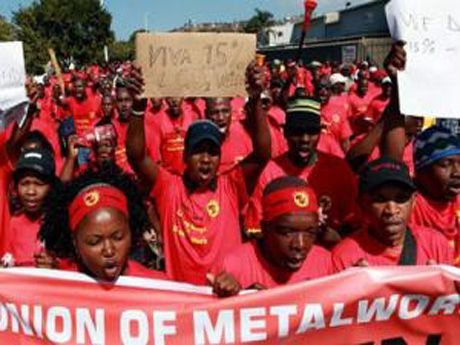Shared
You are here
A new workers' party in South Africa?

March 19, 2014
In the single most important political development in South Africa's post apartheid history, the National Union of Metalworkers (Numsa) has decided to challenge the leadership of the country's main trade union Cosatu federation, and particularly its decision to dismiss the general secretary, Zwelizima Vavi.
Together with nine of the other unions in 19-strong Cosatu federation, Numsa has called a Cosatu special national congress, to be held later this year. It is a move that has already created enormous political tension, with threats by Cosatu's leadership to take court action in order to prevent the congress ever taking place. At its own special national congress, just a week after Nelson Mandela's death in December, Numsa initiated a united front of trade unions and left forces inside civil society centered on days of action. Most importantly, the united front will be used to catalyse the process of forming a workers party. A conference on what Numsa's leaders are calling a Movement for Socialism will be held later this year. By 2015, they hope to have formed the shape of this new organisation.
The way Mandela's death was greeted by many South Africans, and particularly the comparisons they made between him and the country current leader Jacob Zuma, displayed a new insurgent mood - one fueled by the 20-year-old policy of wage compression. After 1994, bosses, feeling more confident that apartheid was over, were unwilling to concede to high wage demands. Union leaders inside Cosatu, now in an alliance with the ANC government and the South African Communist Party (SACP), bought in the idea that their role was to stabilise the economy. Wage levels remained stagnant for all categories apart from highly skilled workers.
In the past six years, unemployment has risen sharply and stands at a record 35-40 percent. At the same time basic food prices have skyrocketed. A wide-scale perception of the ANC government as uncaring has been compounded by rampant corruption at top ANC leadership level, filtering down to local government. What has tipped the balance is inequality. Government policy continues to reinforce the notion that wealth redistribution is only achievable via economic growth. This pandering to capitalist accumulation at the expense of people's basic rights, to water, electricity, housing, even refuse collection - a legacy bequeathed to us by Mandela - now places South Africa as the most unequal country in the world.
The response has been an explosion in the levels and intensity of protest. South Africa enjoys the highest number of protests worldwide, on average 7,000 per year. Strikes since 2010 have also spiked considerably. A titanic six-week public sector strike that year witnessed the beginnings of a class in revolt, as teachers and nurses taunted Zuma with lewd songs that deeply humiliated ANC loyalists.
Under Zuma, the SACP has been rewarded for its support with high political office, a host of MPs and important state jobs. But the government has continued to ignore the demands of organised labour, and the prevalence of large-scale corruption in the state.
Everything came to a head in August 2012 with the Marikana massacre. The largest trade union inside Cosatu, the 320,000 strong National Union Mineworkers (NUM), under the sway of the SACP, was rapidly losing membership and credibility among mineworkers. Something had to be done. At the Cosatu congress a month later, the SACP pushed ahead with a strategy to remove Vavi - the most vocal critic of the government's neo-liberal policies. It proved unsuccessful.
That same month saw an outbreak of 45 unofficial strikes, first in the mines, then spreading to heavy industry and to farmworkers. This expressed two things clearly. Union leaders had lost touch with their base, and workers were both desperate and angry enough to take on their bosses, despite the real threat of losing their jobs.
At the end of 2012, Cyril Ramaphosa, the former leader of NUM, now a billionaire largely from his investments in mining, was elected as the deputy president of the ANC. This significant shareholder of Lonmin, the owner of the Marikana mine, had used his influence within government to criminalise those who had embarked on a wildcat strike.
Numsa, with the finest political traditions, was not spared from this attack. But unlike the NUM it chose to face the challenge. In essence it resolved that it was fruitless to be part of an alliance with the SACP and ANC that sought to turn the trade unions into a conveyor belt for the ruling party and its capitalist partners. Hence its formation of a united front to oppose both the ANC and SACP, and work toward the establishment of a workers party.
The Democratic Left Front, the most sizeable anti-capitalist network, is actively involved in building community and mineworker support for action and has pledged its full support for the move towards a new political party. No doubt there will be challenges for revolutionary socialists inside this new party as we attempt to forge a path that will allow socialist politics to shape the class struggle.
Rehad Desai has made a film Miners Shot Down about the Marikana massacre. This article is republished from Socialist Review
Section:










